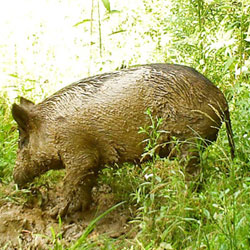Main Content
Article
Feral / Wild Hog
Wild pigs—also called wild hogs, wild boar or feral pigs—are an invasive species in Indiana.  Wild pigs have either been illegally released or were formerly domesticated pigs allowed to become feral (see IAC 9-3018.6 for full definition). These animals pose significant threats to both agricultural and ecological health.
Wild pigs have either been illegally released or were formerly domesticated pigs allowed to become feral (see IAC 9-3018.6 for full definition). These animals pose significant threats to both agricultural and ecological health.
General Characteristics
Wild pigs are mid-sized hoofed mammals with a long, pointed head, short legs and a stocky build. They vary in color and size, but some general characteristics are:
- The average female weighs 110 pounds; the average male weighs 130 pounds.
- Hair is course and denser than a domestic pig, with long bristles.
- Most are black.
- Snout is flat and long.
- Tails are straight, never coiled like that of a domesticated pig.
- Males have four continuously growing tusks that are 3-5 inches long.
Distribution and Abundance
There is no established population of wild pigs in Indiana. The home territory of a wild pig is around 10 square miles. They nest in dense vegetation and thickets.
Food Habits
Wild pigs are opportunistic feeders. They prefer acorns and hickory and beech nuts in the fall. Other food items include grasses, leaves, berries, fruits, insects, crops, insects, crayfish, frogs, salamanders, snakes, mice, eggs of ground-nesting birds, young rabbits, fawns and young livestock, such as lambs and goats. Pig activity along streams and rivers can muddy up the water, covering fish spawning beds in silt and decreasing oxygen levels.
Wild pig rooting also damages crops, parks, lawns and rural cemeteries. They also compete with native wildlife for food. Some wildlife such as deer and nesting turkeys, avoid areas were pigs are active. Damage to wildlife nesting, winter cover, food plots and water holes by wild pigs is common.
Management and Control
A landowner, tenant, or other person with written permission of the landowner can shoot or trap a wild hog on that landowner’s private property without a permit. Be sure to check local ordinances before using a firearm. If trapped, the hog must be killed at the trap site or euthanized immediately after moving it from the trap site. However, wild hogs cannot be offered for compensation of any kind for hunting or taking purposes and cannot be released into the wild. A person cannot charge a service fee for shooting, trapping or removing a wild hog from private property unless the person has a nuisance wild animal control permit from the Division of Fish & Wildlife.
The DNR, in cooperation with the USDA-APHIS Wildlife Services and the Indiana State Board of Animal Health (BOAH), are working with impacted landowners in providing technical information to control wild hog populations. The DNR, BOAH and USDA-APHIS Wildlife Services do not provide information on where to hunt wild hogs in Indiana as part of this cooperative work with landowners.
Wild hogs cannot be imported into Indiana, possessed in captivity, sold, traded, bartered, leased or gifted.
Wild hogs can cause significant damage to property, destroy wildlife habitat and can carry diseases that transfer to domestic swine and other animals. Wild hogs are a major concern to farmers because they cause extensive damage to crops, are a source of disease for domestic livestock, and will prey on young livestock and small animals. Wild hogs may carry diseases that can infect people. They also contaminate human food sources and water supplies. Wild hogs have reaped havoc on residential lawns, landscaping, golf courses and rural cemeteries in other states.
If I see wild pigs, what should I do?
Individuals observing wild pigs are asked to contact one of the following to report the approximate location and number of hogs observed:
- Indiana USDA-WS at 855-386-0370
- Indiana Division of Fish & Wildlife at dfw@dnr.IN.gov
Individuals observing the illegal possession, importation or release of wild hogs should contact DNR Law Enforcement at 1-800-TIP-IDNR.
